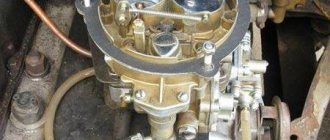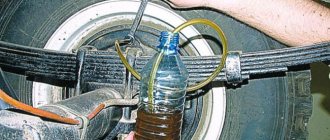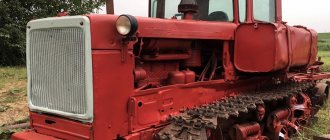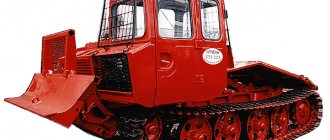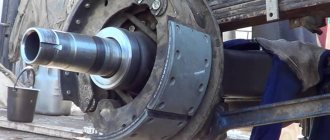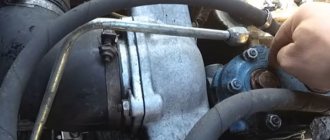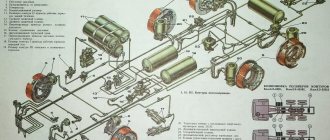Farmers are interested in how to adjust the MTZ-82 brakes, the design of which they would like to know. Brakes for Minsk Tractor Plant products, including equipment such as the MTZ-82 mini-tractor, are needed so that the tractor driver can reduce the speed of movement, completely stop the agricultural machinery and keep it stationary when required. In addition, the braking system can allow you to maneuver more efficiently and enter braking turns when necessary.
Brake device MTZ-82
The Belarus tractor is usually equipped with dry disc brakes. They are installed on the shafts of the key gear wheels. They stand on both sides, and special protective covers are placed on top of them.
The MTZ-82 brake system consists of several elements:
- Two connecting disks, which are combined with the help of special devices with the final drive gears.
- Friction linings glued to discs.
- A pair of pressure plates, which are made of cast iron material and are connected to the first structural element.
Between the last elements, several expansion balls are installed, which are positioned along the entire circumference with equal distances from each other. These balls must fit into special inclined sockets, which are made from the inside on the pressure disks. Inside, the design of the tractor brakes is completely protected from the leakage of oil contained on the rear axle. The protection is made by installing a special pair of self-clamping cuffs on the lid of the glass. The lid, in turn, receives a seal with a rubber ring.
Principle of operation
Before you figure out how to tighten the brakes on MTZ, you should familiarize yourself with the operating principle of such a unit. It is extremely simple and provides that when you press the pedal, the rods are shifted, activating the roller and lever mechanisms of the brakes. By means of washers and bolts, force is transmitted to the forks, which activate the pressure plates.
The system then operates according to the following algorithm:
- The disks unfold, which leads to the movement of spherical elements along the surfaces.
- The linings placed in the disk joints are pressed against the glass of the device, due to which the gears responsible for the movement are braked.
- After a successful stop or cessation of pressure on the brake pedal, all mechanisms return to their original state due to the presence of spring mechanisms located in various places in the structure.
It is allowed to use only one of the brake pedals to stop, which will lead to a partial stop of the moving components and will allow maneuvering when driving the tractor. However, such actions are advisable only at low speeds, which do not exceed 10 km/h, otherwise there will be a high probability of the unit overturning.
A special latch deserves mention, which allows you to successfully fix the position of both brake pedals. With its help, you can provide comfortable conditions when working on a slippery road or slope.
How does the MTZ-82 brake system work?
The brakes on the MTZ-82 operate as follows. When you press the brake pedal, the special brake rods of the cushions move down, thereby turning the roller and levers. After this, the force is transmitted to the forks using spherical washers and bolts. Using traction and fingers, they are firmly attached to the pressure plates. These disks, under the influence of traction, unfold and thereby move the spheres along systems located at an angle, and the disks expand.
Using the same discs, the linings located on the connecting discs are pressed against the cup cover and the brake casing. After this, the key gear wheels responsible for the final drive slow down, and the tractor wheels stop. The pedals and discs are brought to their original position by the action of special springs and pressure discs.
When braking, all wheels can stop either simultaneously or separately.
In this case, the technique of applying different influences on two pedals is used if it is necessary to provide the tractor with additional maneuverability. Be careful, because you should not allow a single wheel of agricultural machinery to brake when the machine accelerates at more than a speed of 10 km/h. This is dangerous because it can ultimately cause the machine to tip over. In order to simultaneously use the right and left brakes, it is necessary to lock both pedals using the connecting bar. The mode in which all wheels stop at the same time is standard, which is why it is necessary to constantly ensure that the pedals are locked.
The design of the MTZ-82 brakes assumes that the tractor driver can fix the pedal in the braking state. A similar action can be performed using a special latch equipped with teeth, which is controlled by the thrust acting on it. The traction, in turn, is affected by a handle, which is installed near the right wall of the driver’s cabin. When using the handle, the latch is rotated to the desired position and secured to the stop, which is located on the lever of the desired pedal.
If you work on slopes or in slippery road conditions, then in order to achieve better braking, experts recommend manually engaging the front axle.
In order to ensure a long service life for the brake system, the following rules must be followed:
- Do not press the brake pedal unless necessary. This will lead to rapid failure of the friction linings.
- Brake smoothly, pressing the brake fully and not fixing the pedal at any intermediate level.
- Disengage the clutch when braking.
- Do not forget to remove the latch that holds the pedals in the brake position when you begin to set the Minsk modification tractor in motion.
Adjustment
Efficiency is tested on a dry, hard-surfaced road. When braking at a speed of 25 km/h, the braking distance to a complete stop should not exceed 9 meters. The difference in the length of the left and right brake tracks should not exceed 1 meter. If there is a discrepancy, additional adjustments are made to the lagging side.
Adjusting the pedal stroke
The setting consists of adjusting the travel of the drive brake pedals. Proper adjustment ensures even braking on the left and right sides. The pedal stroke should be 70 - 90 mm for tractors with a small cabin; with a large overview cabin, the free stroke should be 110 -120 mm. Adjustment is carried out by changing the length of the adjusting screw 2 . Increased pedal travel reduces braking efficiency; reduced pedal travel leads to premature wear of the disc linings. To achieve simultaneous braking with interlocked pedals, the travel of the left brake pedal must be 5-20 mm less than the travel of the right one.
The lack of threaded part of the adjusting screw during adjustment indicates unacceptable wear of the brake discs or contact surfaces.
Adjusting the parking brake
Correctly setting the handbrake ensures complete blocking of the wheels and holds the tractor on a slope of 18%. Adjustments are made in the following order:
- set the lever to the forward position, releasing the brake
- unscrew the locknut of the adjusting screw 1 and the locknut 7 , then release the connecting pin,
- turn lever 4 and align the upper edge of groove B1 of lever 2 with the upper edge of groove B2 of lever 3 of the right brake pedal, and then, rotating fork 6 , align the holes of lever 4 and fork 6 and insert pin 5
- By tightening or unscrewing screw 1, select the position in which the brake is tightened with a lever with a force of 400 N in the position between the third and fourth click of the latch. Finally, tighten the control nuts of the adjustable rods.
The adjustment of the brake system controls is monitored during scheduled maintenance at intervals of 500 working hours.
Adjusting the trailer pneumatic brake control drive
The mechanical control drive is connected in parallel to the control drive of the pneumatic brake valve. the “brake valve opening” 1 3 installed on the rod are adjusted The length is adjusted so that in the free position of the brake controls the gap between the upper edges of the grooves and levers 6 and 7 is 1-2 mm. The length of spring 3 should be 37 mm and is adjusted by rotating the thrust nut 2 on the threaded part of the rod 1 .
To ensure sufficient force, air regulates the pressure in the pneumatic line for controlling the trailer brakes. To adjust, disconnect drive rod 1 in conjunction with the pneumatic valve under the rubber casing 8 . Unscrew the eye 9 of the joint several turns and by rotating the adjusting nut set the pressure in the line to 7.7 kgf/cm2. Then fix the position with a lock nut, connect the eye with the rod and install the rubber casing.
How to adjust the brakes of MTZ-82
Let's look at how the brakes are adjusted. There are often cases when a farmer has an MTZ-82 problem, why do the brakes on the MTZ-82 jam? The problem may lie in non-compliance with the above rules. Brakes need to be inspected regularly, preferably daily. If you see that something is wrong with them, you need to make adjustments.
Absolutely any tractor driver can adjust the brakes independently. You can understand that they need adjustment by looking at the length of the braking distance and the full travel of the pedal. The full stroke should be about 90 mm. If you understand that the pedal does not travel that distance and is sticking, then this is a reason to resort to adjustment.
Adjust the pedal travel as follows:
- Remove the lock nuts of the bolts and screw them into the adjustment forks until the pedal travel becomes acceptable.
- Install and tighten the locknuts.
Regulatory actions, as mentioned above, must be carried out regularly when the need arises. The brake check should be performed on a flat, dry area. Typically, at a vehicle speed of 30 km/h, the tractor braking distance should be no more than 10 m from the moment the pedal was pressed.
To understand whether both sides of the wheels are braking evenly, it is enough to look at the marks that the tractor left on the ground after the equipment was stopped. The unevenness should be no more than 1 m along the entire trail. If you see that one of the sides is lagging, adjust the travel of the pedal responsible for that side. Please note that braking may be uneven due to oil leaking into the brake system and onto the brake linings.
Adjustment
Efficiency is tested on a dry, hard-surfaced road. When braking at a speed of 25 km/h, the braking distance to a complete stop should not exceed 9 meters. The difference in the length of the left and right brake tracks should not exceed 1 meter. If there is a discrepancy, additional adjustments are made to the lagging side.
Adjusting the pedal stroke
The setting consists of adjusting the travel of the drive brake pedals. Proper adjustment ensures even braking on the left and right sides. The pedal stroke should be 70 - 90 mm for tractors with a small cabin; with a large overview cabin, the free stroke should be 110 -120 mm. Adjustment is carried out by changing the length of the adjusting screw 2 . Increased pedal travel reduces braking efficiency; reduced pedal travel leads to premature wear of the disc linings. To achieve simultaneous braking with interlocked pedals, the travel of the left brake pedal must be 5-20 mm less than the travel of the right one.
The lack of threaded part of the adjusting screw during adjustment indicates unacceptable wear of the brake discs or contact surfaces.
Adjusting the parking brake
Correctly setting the handbrake ensures complete blocking of the wheels and holds the tractor on a slope of 18%. Adjustments are made in the following order:
- set the lever to the forward position, releasing the brake
- unscrew the locknut of the adjusting screw 1 and the locknut 7 , then release the connecting pin,
- turn lever 4 and align the upper edge of groove B1 of lever 2 with the upper edge of groove B2 of lever 3 of the right brake pedal, and then, rotating fork 6 , align the holes of lever 4 and fork 6 and insert pin 5
- By tightening or unscrewing screw 1, select the position in which the brake is tightened with a lever with a force of 400 N in the position between the third and fourth click of the latch. Finally, tighten the control nuts of the adjustable rods.
T 40
The wheeled tractor of the Lipetsk plant, version T 40, is equipped with dry belt-type brakes. They are equipped with two tightening ends with separate controls and a bar for general locking.
Servicing the braking system of the T 40 model involves checking the tightness of the seals, washing the linings and timely adjusting the brake. The first signal of problems in the system and wear of the linings is a change in the free play of the pedal. In this case, it is necessary to adjust the position of the tape:
- unscrew the bolts and remove the hatch cover;
- unscrew locknut 3;
- tighten the nut and check the pedal travel, which should be within 50-80 mm;
- Once the desired parameter is reached, secure the nut with locknut 3.
If the adjustment is carried out correctly, the outer lever of the left brake will move 8° back vertically, and the right one will move 10° back in the same direction. When carrying out work, the pedals must be moved to the rearmost position.
According to the standard maintenance schedule, the brake system is carried out every 240 operating hours. To ensure a uniform gap, change the position of the tape:
- release locknut 16 of screw 15;
- The screw is screwed in until it stops, and then turned another ¾ and secured with a lock nut.
The T 40 tractor requires repairs if the linings become oily. First, they are washed. To do this, remove the hatch cover and pour 1.5-2 liters of kerosene inside. Then the lid is closed and a run-in is carried out, moving the machine back and forth. After stopping the equipment, the spent kerosene is drained by first unscrewing the adjusting screw. After washing, the position of the tape is changed according to the diagram given above. Repeated oiling is eliminated by replacing the sealing ring or cuff.
